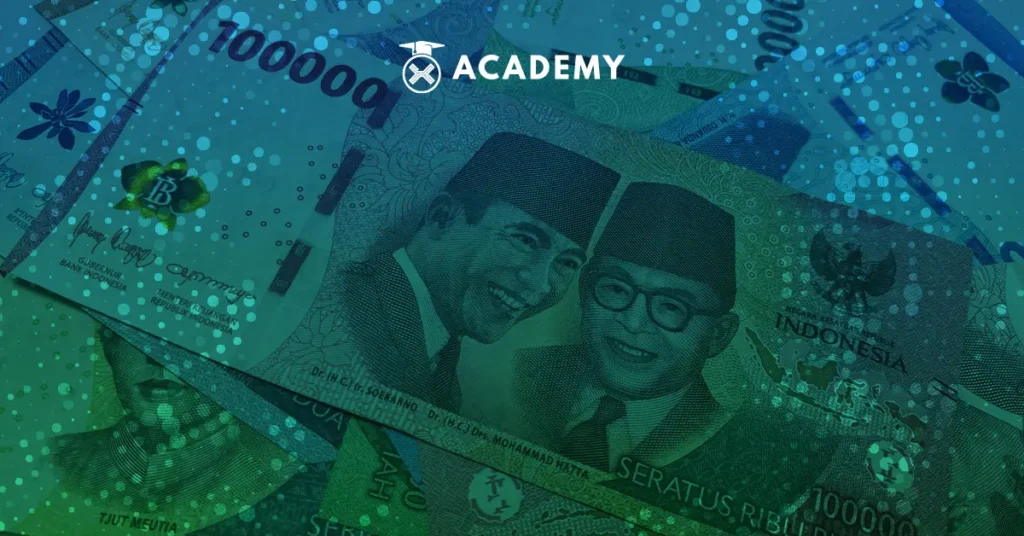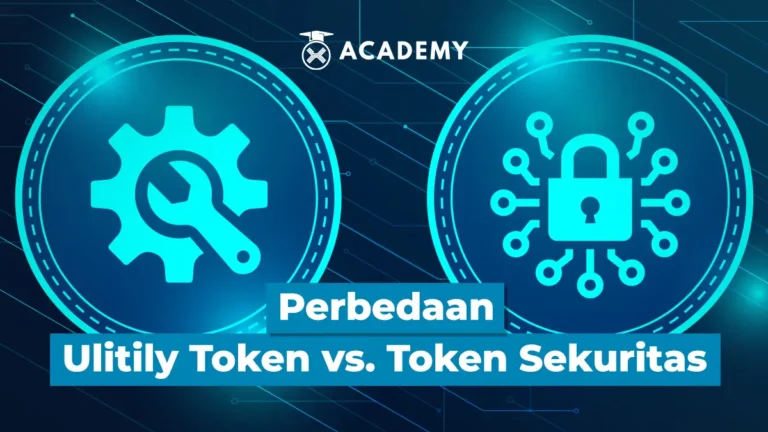Indonesia has an official currency known as the Indonesian Rupiah (IDR). As the legal tender used in economic transactions throughout Indonesia, the IDR reflects the prevailing currency exchange rate in the country.
The symbol of the Indonesian Rupiah (IDR) is “Rp”. In daily transactions, IDR is used as a means of payment for various needs.
IDR is generally used in daily transactions, including purchasing goods and services, bill payments, and other transactions in the domestic economic market.
Now, to better understand what IDR is, its history, exchange rate fluctuations, differences with RP, and what Rupiah Token (IDRT) is, see the full review below.
What Does IDR Mean in Currency?
When entering the forex market, we can find various currency symbols used by countries worldwide, including IDR. The question is, what does IDR mean, and which country’s currency does it represent?
IDR stands for Indonesian Rupiah, which is the official currency of Indonesia. In full length, IDR can be interpreted as Indonesian Rupiah.
In more detail, IDR is Indonesia’s legal and valid currency, has a certain value based on its nominal value, and functions as a transaction tool in economic activities.
In foreign currencies, the IDR is commonly used as the exchange rate between the United States and Indonesia. For example, if we look at the USD/IDR currency pair, it indicates the value of 1 USD when converted into IDR or Indonesian Rupiah.
It is important to note that IDR is used for exchange rates with the United States and other countries’ currencies. For example, the JPY/IDR currency pair is for the Japanese yen, EUR/IDR for the Euro, SGD/IDR for the Singapore dollar, and many others.
History of Indonesian Currency (IDR)
Based on the previous explanation, it is clear that IDR stands for Indonesian currency, which also reflects the country’s identity. However, when did IDR come into effect, and what are its origins? Here is the full explanation.
Before Independence
The history of IDR currency in Indonesia has a long history. Initially, no official currency was used for transactions and exchanges in Indonesia. Each region had its own type of currency.
In the period 896-1158 AD, Javanese people used Krisnala as a medium of exchange. Krisnala is a semicircular, triangular, or rectangular piece of precious metal with a stamp. The stamp was in the form of three leaf buds, flowers, or a crest.
In Bali, Sumatra, and Java, there is a Masa currency. Masa is a medium of exchange made of silver with a concave side and a convex side. The stamp used usually reads “ma”.
In the 14th century, Kepeng currency began to enter Indonesia brought by Chinese traders, along with Gobog currency made of brass and copper.
In the 18th century, the Kingdom of Palembang issued Piti Teboh and Piti Buntu currencies made of tin and copper. During the Dutch colonization, the currency used was VOC.
During the Japanese colonization, the use of currency with writing in Dutch was banned. In response, banknotes with the Indonesian language and Rupiah units were introduced. Although the colonial period ended, the Rupiah currency has survived to the present day.
After Independence
The Rupiah was first adopted during the Japanese colonial period but experienced significant development after Indonesia gained independence on August 17, 1945. The following is an explanation:
- ORI and ORIDA: ORI stands for Oeang Repoeblik Indonesia which consists of denominations of 1 cent, 5 cents, 10 cents, Rp1/2, Rp1, Rp5, Rp10, and Rp100. After two years, ORIDA or Oeang Repoeblik Indonesia Daerah began circulating, where each region had its own currency.
- RIS: The RIS was introduced in March 1950 and signaled that ORI and ORIDA were no longer valid. The RIS currency, representing the United Republic Government, only lasted 5 months.
- Serial Money: Since 1952, Bank Indonesia (BI) issued various series of Rupiah banknotes, including the culture series, the animal series in 1957, the Sukarno series in 1947 and 1960, the volunteer and handworker series in 1964, and the Sudirman series in 1968.
- In 1965, there was 635% inflation, which resulted in introducing a new exchange rate where 1 new Rupiah was equivalent to 1,000 old Rupiahs.
- In 1997, the Asian financial crisis caused a slump in the IDR exchange rate. Compared to the USD, the IDR has a small value, i.e., 1 USD = IDR10,000.
Subsequently, the development of the Rupiah focused more on printing new series, both coins and banknotes.
IDR Exchange Rate Fluctuations

Quoting merdeka.com, between 1949 and 1952, the exchange rate of the IDR against the US dollar (USD) was 3.8. In 1950, the country introduced different tariffs for imports (11.4) and exports (7.6) but later canceled them and returned the rate to 3.8.
In 1952, the currency was devalued to IDR 11.4 per USD. Although the government tried various tariff approaches to stabilize the currency and increase revenue, the efforts failed.
Although the official rate remained at 11.4, on the black market, the currency’s value dropped to 31/USD in 1956 and Rp90/USD in 1958. The exchange rate is usually expressed as USD/IDR when looking up currency quotes. For example, if the exchange rate is 14,234, it costs Rp 14,234 to buy one USD.
To determine the value of one Rupiah in USD, divide one by the exchange rate. For example, if the exchange rate is 14,200, the quotient of one by 14,200 is 0.00007. This is the IDR/USD exchange rate, which means $0.00007 is equivalent to one IDR.
What is the Difference between IDR and RP?
Quoting detik.com, it is important to note that IDR stands for Indonesian Rupiah based on ISO code 4217. In other words, IDR is the international representation of Indonesia’s currency, the rupiah.
ISO 4217 is an international standard set by the International Organization for Standardization (ISO) that contains a three-letter code (known as the currency code) to determine the name of a currency.
According to the ISO website, the ISO 4217 standard establishes an internationally recognized code to represent currencies and reduce errors. The currency representation can be three digits or letters, either numerically or alphabetically.
The alphabetic code is based on another ISO standard, ISO 3166, which includes codes for country names. The first two letters of the ISO 4217 three-letter code correspond to the code for the country name, and if possible, the third letter corresponds to the first letter of the currency name.
For example, USD represents the United States dollar currency, where US stands for United States and D for the dollar.
Another example is the Swiss Franc currency represented by CHF, where CH refers to the Swiss code in ISO 3166 and F to the franc.
The same principle is applied to the coding of Indonesian currency, where the code for Indonesian currency is IDR. ID stands for Indonesia, while R stands for rupiah.
So, it can be concluded that there is no difference between IDR and Rp. Both are representations or abbreviations for Indonesian currency, with IDR being more commonly used internationally, while Rp is more often used in domestic contexts.
Getting to Know Rupiah Token (IDRT)

Rupiah Token (IDRT) is a pioneering stablecoin guaranteed by Rupiah, issued by PT Rupiah Token Indonesia. IDRT is currently available on various global crypto exchanges and major blockchain platforms.
Each 1 IDRT is equivalent to 1 Rupiah. IDRT is designed based on blockchain technology, allowing us to send Rupiah worldwide quickly and instantly.
What is the Usefulness of Rupiah Token (IDRT)
IDRT has a variety of uses in transactions on top of blockchain or cross-border transactions, such as:
- Trading on various global crypto exchanges.
- Interacting with smart contracts on blockchain platforms like Ethereum.
- Sending money from overseas to Indonesia or vice versa for family and other purposes.
Pros and Cons of Rupiah Token (IDRT)
Quoting the IDRT whitepaper on rupiahtoken.com, the following are some of the advantages and disadvantages of Rupiah Token (IDRT) that are important to know, including:
Pros of IDRT
- IDRT is built on the Ethereum blockchain, thus providing the security and transaction invariability inherent to Ethereum.
- IDRT follows the ERC-20 token standard, making it easy to integrate and inherently compatible with many Ethereum-based applications.
- All transactions are made according to smart contract rules that eliminate human error.
- The security of IDRT smart contracts has been audited and verified by CertiK, a world-class Smart Contract Auditor. IDRT is ready to be listed on all exchanges around the world.
Cons of IDRT
- As with all ERC-20 tokens, transaction confirmations follow the speed of the Ethereum network (around 1-3 minutes). This is much faster than Bitcoin but still slower than the ideal user experience.
- As part of the Ethereum blockchain protocol, all transactions on the Ethereum network require the initiator of the transaction to pay a “gas” fee in the form of Ether (ETH), the native crypto asset of the Ethereum blockchain. This “gas” cannot be paid with IDRT or other ERC-20 tokens. However, side chain/sharding technologies, such as Plasma and Raiden Network, may overcome this compromise.
- The gas fees required by the Ethereum blockchain network vary depending on network load/congestion. As a rough estimate, a typical transfer fee is around 0.0005 ETH, equivalent to $0.07 USD.
Difference between IDR and IDRT
Quoting coinvestasi.com, IDR and IDRT have elements of the rupiah but have significant underlying differences. Here are the differences between IDR and IDRT.
- IDR (Indonesian Rupiah): IDR is the official currency code for the Indonesian Rupiah. It is a standard abbreviation used to identify currencies in financial and international contexts.
- IDRT is a specialized notation used in the context of crypto assets. It refers to a stablecoin known as Rupiah Token, which is a digital asset pegged to the value of the Indonesian Rupiah. IDRT is often used on crypto platforms to distinguish it from traditional IDR. In simple terms, IDRT is a digital representation of the Rupiah within a blockchain network.
Conclusion
In conclusion, the link between IDR and crypto investment, especially IDRT, demonstrates the close relationship between conventional currencies and crypto assets.
In this case, as an IDR-based stablecoin, IDRT serves as a bridge between the traditional currency world and the crypto market.
Furthermore, as a disclaimer, before engaging in any investment activity, it is important to understand the crypto world thoroughly, including the risks and potential rewards involved.
Relatedly, conducting in-depth research before making any investment decisions is also important. With an in-depth understanding, we can make good investment decisions that suit our individual risk tolerance.
Trading with Over-The-Counter (OTC) Feature on INDODAX
Now, you understand what IDR is, its history, exchange rate fluctuations, differences with RP, and what Rupiah Token (IDRT) is.
Furthermore, if you plan to use personalized services to buy and sell crypto assets in large enough quantities that cannot be processed through the order book, and if you are interested, you can visit the OTC crypto page on INDODAX.
Please note that OTC service prices will always follow market price movements because transactions are carried out on the spot market. Even if the number of purchases increases, this does not guarantee a price drop.
This service is focused on the convenience of transactions for users, with a dedicated team that will guide through all procedures that ensure security and maintain user privacy.
So what are you waiting for? Start OTC transactions on INDODAX now!








